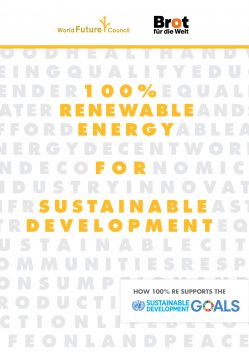How much fossil fuels are needed to build a CO2 free energy system?
…Or: Is the energy demand needed for a fast 100 RE transition so high that it could hinder the speedy global reduction of CO2?
The World Future Council and LINGO joined forces to study this concern in more detail. The result? From a global carbon budget perspective, the energy transition to 100% renewable energy needs less than a year’s worth of global emissions.
How do we come to this conclusion? Our experts Dr. Matthias Kroll (WFC) and Kjell Kühne (LINGO) estimated the additional energy required and the related CO2 emission generated to build a 100% RE infrastructure. As a starting point, the global energy demand figure of 23.6 Terawatt in 2050 was assumed (Greenpeace Energy Revolution, 2015, page 13). Of course, energy needed to produce RE units decreases over time and also differs depending on the technology used, so we can only roughly estimate the size of the CO2 emissions generated by the energy transition.
Our calculation shows that about 25 GtCO2 will be emitted to build a 100% RE system. Currently, the world emits 40 Gt CO2 annually:
| Unit | Source/Comments | ||
|---|---|---|---|
| Installed RE Capacity 2015 | 1.8 | TW | http://www.ren21.net/wp-content/ uploads/2016/06/GSR_2016_Full_ Report.pdf |
| RE Capacity to be built 2015-2050 | 21.8 | TW | |
| Percentage Solar PV | 50 | % | |
| Percentage Wind Power | 50 | % | |
| energy needs for building solar panels | 4000 | MJ/m2 of solar panels | http://www.clca.columbia.edu/ Task12_LCI_LCA_10_21_Final_ Report.pdf |
| 1m2 solar panel capacity | 150 | W | |
| Current Emissions Intensity of electricity | 0,5 | kgCO2/KWh | https://www.iea.org/newsroom/ graphics/2015-04-28-carbon-emissions-from-electricity-generation-for-the-top-ten-producer.html |
| Production emissions per W solar capacity | 3.9 | kgCO2e | |
| Wind power emissions | 12 | gCO2e/KWh | IPCC (2014) https://www.ipcc.ch/pdf/ assessment-report/ar5/wg3/ipcc_wg3_ ar5_annex-iii.pdf |
| Wind capacity factor | 30 | % | |
| 20 year energy production per W installed capacity | 52.6 | KWh | |
| Production emissions per W wind capacity | 0.6 | KgCO2e | |
| Production emissions of capacity to be built | 49.7 | GtCO2 | assuming today’s energy mix |
| Production emissions of capacity to be built | 24.8. | GtCO2 | assuming a linear reduction of production emissions from 100% in 2015 to 0% in 2050 |
 For the simplicity of estimating the emissions for capacity additions, we assumed a grossly simplified energy mix of 50% wind and 50% solar energy. At least two things may shift the result: On the one hand, production emissions for solar panels may get reduced faster than in a linear fashion, due to efficiency (as opposed to energy-system decarbonization). On the other hand, we did not calculate the energy needed to build storage capacity and measures to reduce heating needs. These two factors are pointing into opposite directions, so will counterbalance to some degree.
For the simplicity of estimating the emissions for capacity additions, we assumed a grossly simplified energy mix of 50% wind and 50% solar energy. At least two things may shift the result: On the one hand, production emissions for solar panels may get reduced faster than in a linear fashion, due to efficiency (as opposed to energy-system decarbonization). On the other hand, we did not calculate the energy needed to build storage capacity and measures to reduce heating needs. These two factors are pointing into opposite directions, so will counterbalance to some degree.
Concluding from the perspective of a global carbon budget, one could say that the global energy transition to 100% renewable energy comes relatively “cheap” – needing less than a year’s worth of global emissions. However, the science on the long-term impacts of CO2 levels above 350ppm (Hansen et al. 2008) suggests that there is no room for complacency. We urgently need to undertake the transition to a 100% clean energy economy on a global scale to make sure that global warming does not trigger a run-away reaction in the global climate system, involving huge carbon “bombs” such as methane clathrates from the ocean floor that may dwarf human emissions.
While the global 100% RE movement is very encouraging, current policy pathways are far from steering us in this direction. Some governments are actually slowing down the transformation, legislative measures are falling short and fossil energy interest groups are gaining political power.
Instead, policy makers should incorporate these facts when developing their NDCs and national fiscal and energy policies in the coming years. Fossil fuel subsidies must be phased out quickly, energy policies must be redirected towards meeting basic needs in an efficient way, new financing mechanisms for the renewable energy roll-out must be established and above all, investments and support for new fossil fuel extraction and infrastructure must urgently be halted.
Our calculation gives hope that the transition to 100% renewable energy can be achieved without adding a huge burden on atmospheric CO2 levels. This will not happen in time for avoiding climate chaos without substantial additional efforts.



